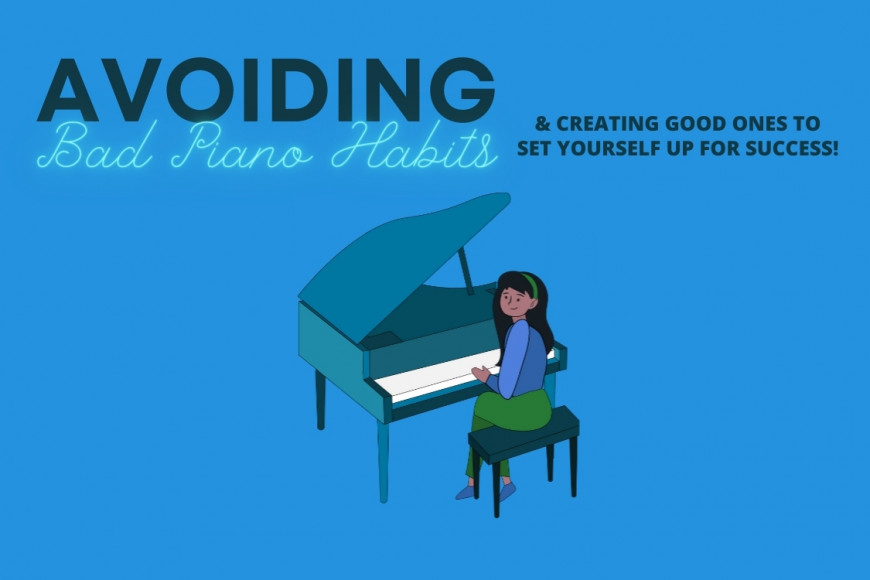Avoiding Bad Piano Playing Habits and How to Set Up for Success

The Piano is a Great Instrument for Overall Music Education
Knowing the piano is an important visualization tool to help expand your overall knowledge of music, especially music theory. The piano is just a great foundational instrument to learn to play while learning the basics of musicianship — counting and rhythm, tempos, melody, harmony, and more. Playing the piano keys also allows for wonderful musical expressiveness, interpretation, and emotion as you progress in your abilities. Therefore it really becomes important as you play to be aware of the bad playing habits that can take you off course, stall your playing, and lead to frustration. The Lessonface Piano Pass subscription of daily access to great group live online piano classes taught in-real-time with expert teachers will help perfect your playing.
What’s Wrong with Bad Habits? Top 4 Reasons Bad Habits are Bad for You
No matter where you may be in your playing, beginners to advanced, bad habits will stall your progress. Bad habits are labeled bad because they will:
1. Keep you from reaching your potential
2. Limit your playing and even frustrate you
3. Put a strain on your body not allowing you to play efficiently, effortlessly, and quickly
4. Cause an overuse of a bad position which can lead to injuries
“Piano playing is a whole-body exercise. We want to avoid excess tension at all costs!” states Kati Falk-Flores, Lessonface Piano teacher & composer
Top 4 Finger Bad Habits to Avoid
10 fingers, all different lengths. Many times people ask “Can I play the piano with short fingers? Or say, “My hands are too small to reach all the keys.” You can play the piano no matter your hand or finger size. The key is to steer clear of bad habits. The top bad finger habits to avoid are:
1. Flat fingers. You do not want to play with a flat hand position. You want to gently round the fingers. This positions all your fingers at a more equal length!
2. Flying fingers. You do not want your fingers lifting off the keys to wait their turn. All fingers should rest on the keys, ready to play.
3. Looking at your fingers. You do not want to look at your fingers the whole time you are playing and not look up at the music. (You’ll get lost and won’t play smoothly!)
4. Not using the correct fingering. Finger numbers do matter! They set you up for the best hand position for each measure of music.
Other bad habits that you may not even be aware of, but worth taking notice of are:
Your posture.
Piano is mostly done in a sitting position, so like working at a desk or sitting at your computer, you need to be mindful of how you are seated. Do you have a good chair? Are you too low or too high? Sit straight and tall, lean slightly forward, and remember to take mini breaks to stand up and stretch. Good piano posture uses our skeletal structure efficiently to support our movements with minimal muscular tension and effort.
Not learning to read music.
While there are many famous musicians, like Jimi Hendrix, Taylor Swift, and Lionel Richer who did not learn to read sheet music, it is widely suggested that learning to read the music notes on the staff and recognize the treble and bass clef helps to progress your playing more quickly. Reading music will allow you to play a much wider variety in music and understand music fundamentals more easily than purely playing by ear or other notational systems. One of the best ways to learn the notes and rhythms is to memorize them using flashcards. Download our free music flashcards perfect for the piano and guitar playing when you sign up for our How to Read Music Notes class here
Poor wrist movement choices.
It is important to be aware of your wrists when playing the piano! Throwing your wrist to the side to reach for high or low notes creates unnecessary tension and jeopardizes your safety. Your wrist and forearm should primarily function as one unit; do be careful not to lock out your wrists through muscular tension to keep the hand, wrist, and forearm as one unit.
Never listening to your own playing.
The benefit of recording your own playing is that you can listen to it later to get an accurate picture of your performance instead of relying on memory or feelings alone. Recording your own playing is one of the best ways to progress in your playing; it gives you specific things to work on and allows you to listen for what you’re doing well!
Overusing the sustained petal.
Overusing the pedal gives off a muddy, dense sound where all the notes run together. For beginners, it is actually best to practice without the pedal at first. Start by working to achieve a good finger legato so that you don’t rely on the pedal more than necessary. After you have learned the piece, you can safely add in the pedal, carefully following the pedal markings or re-pedaling with every chord change. The key is in the timing. Press the pedal immediately after you play a note or chord; keeping the pedal held down you can quickly move your hand to the next chord or note position. When the next note or chord is ready to be played, press that note and let the pedal up at the same time; press down the pedal again to hold your new chord or notes and repeat. You’ll get faster with practice!
Not following the beat or rhythm while playing.
Listen to other musicians play the music you want to learn; it’s a great way to learn and practice rhythm. Be sure to check the time signature at the start of your music and work on learning what rhythmic notation looks like so you can play a piece the right way. Is it 1,2,3, 1,2,3, 1,2,3? Are there tricky rhythmic passages you should practice first? Music compositions are written with a specific tempo and time signature; count it out and use a pencil to mark your music. Draw a long vertical line through each beat in tricky spots; this will help you remember the right counting for that section.
Practice, Practice, Practice
Sometimes as we practice, we may be unintentionally practicing bad practicing habits. Bad habits tend to creep in when you:
1. Do not do any finger technical exercises
2. Compare yourself to others
3. Only practice the fun parts
4. Continue on when you are already frustrated
5. Choose the wrong speed to practice
6. Stop every time you make a mistake
Teacher Tip: Get in the habit of playing through your mistakes. Remember slow and steady. It is not a race.
9 Tips for Creating Good Practice Habits
While we have listed out many bad habits to avoid when playing the piano, these tips will help you succeed in your playing and in your online piano lessons:
1. Play with emotion and be expressive.
2. Play for other people. You can record yourself and share with your friends.
3. Test playing with the metronome to help your pacing and counting.
4. Zen your setup. Be comfortable, have good lighting, and remove distractions.
5. Practice smartly. Use a pencil and make notes like the beat, note names. Writing on your music is good.
6. Set a practice goal for each session. Make mini-goals and write them down.
7. Play music you like and want to play.
8. Give yourself permission to go back and play an easy piece. See your progress!
9. Reward yourself.
Teacher Tip: Break it down, play each hand separately, then put it together. This may take 3-4 or more practice sessions. Give yourself the gift of time.





